Non-Conference Schedule Finalized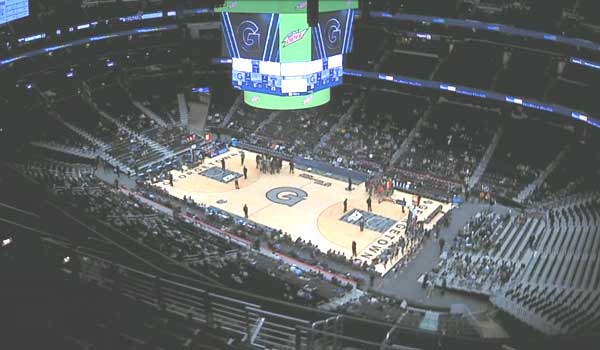 The remaining opponents for the 2022-23 non-conference schedule were announced Tuesday.What do all four teams have in common? Simply put, they are wins. Head coach Patrick Ewing is a combined 8-0 against these teams over the past five seasons.With Ewing and the Hoyas carrying a school-record 21 game losing streak into the 2022-23 season opener, there is metaphysical certitude that the streak ends on November 8 versus Coppin State. The Eagles (2021-22 NET rating: #301) return two starters from a team which started 1-17 last season en route to a 9-25 finish. Georgetown is 3-0 all-time versus Coppin State and undefeated in 100 consecutive games versus HBCU's. Two area schools travel to Capital One Arena for an awkward pairing around the Thanksgiving holiday, as the Georgetown ticket office will seek to attract fans in town the night before the holiday and the Saturday following the holiday to come to the games. The Wednesday before Thanksgiving features American, where the Eagles (2021-22 NET rating: #335) return four starters from a 10-22 season, having lost to the Hoyas by 22 last season. The only team Georgetown defeated by more than American was UMBC (2021-22 NET rating: #233), who lost 100-71 to the Hoyas before just 3,021 at Capital One Arena. The Retrievers return one starter from last season's team. The final announced opponent on the calendar is also a holdover from 2021-22, Siena. The Saints (2021-22 NET rating: #230) lost by 18 to the Hoyas on November 19, 2021 before an announced crowd of 4,460 and will hope for redemption in a midweek game on December 7. Two Siena starters return from that game including forward Jackson Stormo, who scored a career high 25 in last season's game. Game times and ticket prices are pending, but all are scheduled at Capital One Arena. Big East opponent dates and times have not been announced. Here are the NET ratings of the 2021-22 opponents compiled from the prior season compared to the 2022-23 opponents:
Big East Academic Teams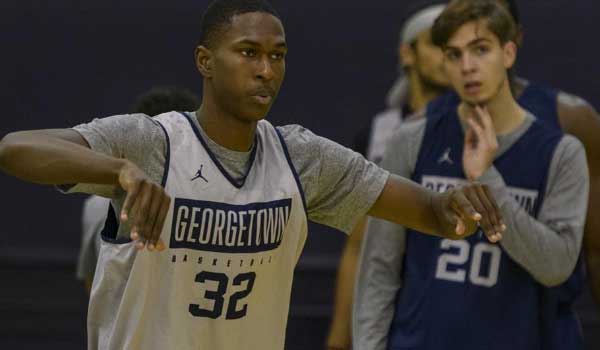 Four men's basketball players are among 334 Georgetown student athletes cited by the Big East conference for its All-Academic-teams, named for players with at least a B average last year.Named for the men's team include former freshman Aminu Mohammed, rising juniors Dante Harris and Victor Muresan, and rising senior Malcolm Wilson. Harris, Muresan, and Wilson are return recipients from 2020-21, when 11 of the 15 players that season posted 3.0 or greater, though six of the 11 have since left the program.Other team selections included 33 players from baseball, 13 for field hockey, eight for men's golf, five for women's golf, 40 for men's lacrosse, 29 for women's lacrosse, 26 for men's track and field, 21 for men's soccer, 25 for women's soccer, 16 for softball, 24 for men's swimming, 24 for women's swimming, 10 for men's tennis, 10 for women's tennis, 10 for volleyball, 12 for women's basketball, and 25 for women's track. Schedule Update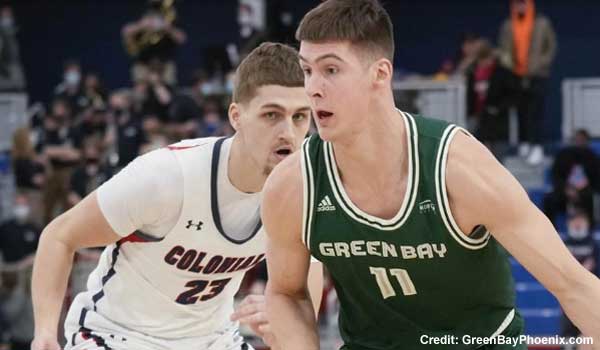 An early November game with the University of Wisconsin-Green Bay is the latest add to the Georgetown schedule.The Phoenix return one starter and four lettermen from a 5-25 team last season, dropping 11 straight before ending the regular season with a win over IUPUI, who finished last in the NET with a 3-26 record. This is the first meeting between Georgetown and Green Bay, who plays in the Horizon League.This game is part of the Jamaica Classic, where four additional schools will play in a separate bracket and return one game to each of the four major conference schools (Georgetown, Loyola-Marymount, LaSalle, and Wake Forest). The other teams include Green Bay, Morgan State (13-15), Utah Valley (20-12), and Queens University (30-4), a new Division I school from Charlotte, NC. Georgetown-Maryland Alumni Game Announced Former players from Georgetown and Maryland will participate in an August 6 exhibition in College Park, MD.Founded by two University of Missouri alumni in 2018, the concept of the Alumni Basketball League caught the interest of former Maryland player Travis Harrison. "I just thought that a Maryland-Georgetown game would be a pretty cool idea," Garrison told Inside MD Sports. "The game was scheduled for next summer, but I got a call a couple of weeks ago in regards to them wanting to make it happen now, and so things kind of just steamrolled ahead."The Georgetown team will be led by former Hoya standout Chris Wright, who has assembled a team of former players from the 2010's known as DawgTalk, the name of a podcast Wright hosts. Players include: Aaron Bowen (2010-2015) Jason Clark (2008-2012) Greg Monroe (2008-2010) Jagan Mosely (2016-2020) Henry Sims (2008-2012) Greg Whittington (2011-2013) Rodney Pryor (2016-2017) The Maryland team, known as the College Park Boys, includes the following: Anthony Cowan Jr. (2016-2020) Damonte Dodd (2013-2017) Travis Garrison (2002-2006) Ekene Ibekwe (2003-2007) Sean Mosley (2008-2012) Byron Mouton (2000-2002) Terrell Stoglin (2010-2012) Romelo Trimble (2014-2017) Dawgtalk is independent from Georgetown, which is one reason the basketball office has not promoted this event on GUHoyas.com or its social media channels. The game will be held August 6 at the Xfinity Center on the University of Maryland campus. Ticket information for the game can be found at this link. Assistant Coach Promoted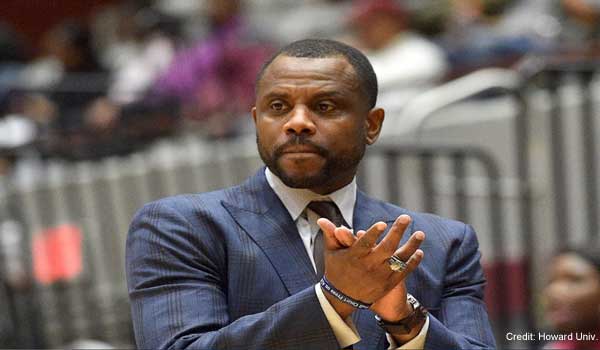 Head coach Patrick Ewing has promoted assistant coach Kevin Nickleberry to the title of associate head coach."He is a person who immediately makes an impact on and off the court wherever he goes and that has been no different here," said Ewing in a news release. "In a short time he has proven that he deserves this promotion and is helping deliver the pieces we need for success."A former assistant at Louisiana State, Nickelberry recruited former LSU transfers Brandon Murray and Brad Ezewiro this season, along with Marvel Allen, a decommit from the Tigers who committed to Georgetown this past weekend. He also helped fill the remainder of the 2022-23 roster following the departure of Aminu Mohammed and the transfers of Tyler Beard, Jalin Billingsley, Donald Carey, Kobe Clark, Timothy Ighoefe, and Collin Holloway. The title of associate head coach is new to men's basketball at Georgetown, but in use elsewhere at GU. Associate head coaches are found in women's basketball, baseball, rowing, and track and field, and were previously found in football and men's lacrosse. In basketball circles, the title can be awarded to former head coaches serving as an assistant, or recruiting coordinators, as Nickelberry is both. Should Nickelberry wants to return to a head coaching position elsewhere, the title is also seen positively by other schools in the hiring process. Per NCAA rules, Nickelberry remains among the three assistants who, along with Ewing, may recruit off-campus. First Verbal For 2023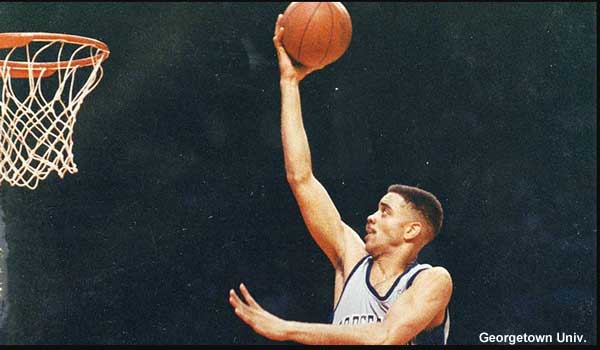 A verbal commit from 6-4 guard Marvel Allen is the first such commit for Georgetown in the 2022-23 recruiting cycle.Allen, a guard from Fort Lauderdale, FL, decommitted from Louisiana State in March following the firing of Will Wade, and maintained ties with current Georgetown assistant Kevin Nickelberry, also late of LSU. Allen averaged 13.8 points per game as a junior at Calvary Christian Academy and will player his senior season at Monteverde Academy outside Orlando.Early 2022-23 Preview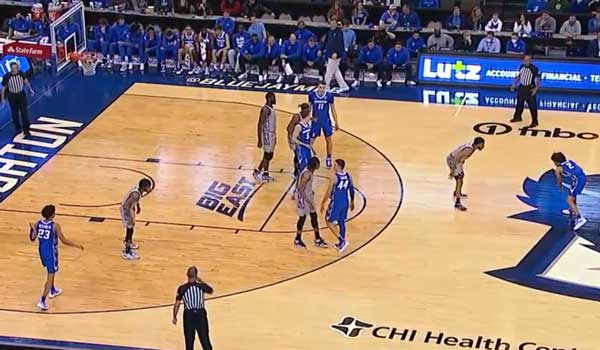
November is a long way away, but the early Big East previews are arriving.CT Insider Picks
2. Xavier 3. Connecticut 4. Villanova 5. St. John's 6. Seton Hall 7. Providence 8. Marquette 9. Butler 10. DePaul 11. Georgetown "Nowhere to go but up," it writes. The preview will be the first of many to place Creighton (23-12 in 2021-22) firmly atop the conference in the post-Jay Wright era. "The Bluejays will deservedly be a near-consensus top-5 preseason pick," it writes. "Creighton brings back the Big East's reigning Defensive Player of the Year (Ryan Kalkbrenner) and Freshman of the Year (Ryan Nembhard), its best player in Arthur Kaluma, and one of the nation's best portal pick-ups in South Dakota State's Baylor Scheierman...And we've seen first-hand how good a coach Greg McDermott is." Georgetown Opens NIL Database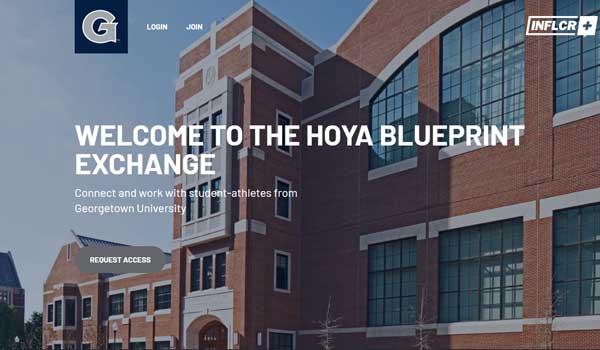 From GUHoyas.com, news of a public-facing portal to facilitate name image and likeness (NIL) inquiries.The "Hoya Blueprint Exchange" offer individuals and businesses interested in pursuing NIL opportunities with student-athletes a single point of contact for registration and follow-up."The Blueprint Exchange will empower student-athletes to be personal business entities through a personalized and adaptive learning experience. Overall, The Blueprint is designed to build lifelong skills that help now and in the future as student-athletes represent themselves or work with outside representation," said the release. NIL activities at Georgetown have been very limited to date, at least publicly. The men's basketball program was invited to two efforts over the past year hosted by alumni in the form of personal appearances, but other GU teams have not announced such efforts. Unlike many states, the District of Columbia has no NIL legislation in force. Commentary: Steady Across The Waves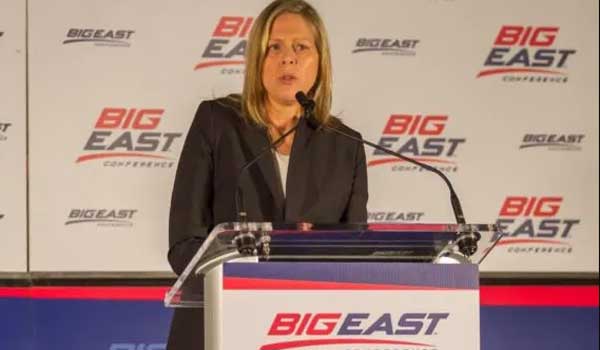 Way back when, one of my earliest columns as a writer for The HOYA asked about the value of conferences in college athletics. In so many ways, times have changed."What makes the Big East conference so successful in such a short time when conferences such as the WAC, Missouri Valley, and Metro 7 have been trying for years?" I asked in a column many years ago titled "A Northern ACC", a reference much different than what it means today. It was, I argued, "a case of good planning."The reference to the Atlantic Coast Conference was entirely complimentary. Not yet 30 years old, the ACC had established itself as a well-run machine, one that leveraged television to portray (and by extension, to confirm) a conference of strength and stability. Little wonder, perhaps, that its most prominent advertiser was the Pilot Life Insurance Company, located just three miles from the ACC offices. Twice a week for three decades, ACC basketball fans were serenaded by the Pilot Life commercial, which could well have been an anthem for the conference itself: Sail with the Pilot, at the wheel On a ship sturdy from its mast to its keel He guides through storm and wave, Insures you while you save... Of course, that's not the ACC anymore. Just seven of its current 16 school lineup were part of those halcyon days. The waves of conference realignment are taking its toll across the nation, most recently with the announcement of a move of USC and UCLA to the Big Ten. In the last 12 months, 44 schools across 21 conferences have announced plans to move, with three major conferences (Pac-12, Big 12, and the aforementioned ACC) in panic mode. Depending on which scenarios drive your interest, any one of these three conferences could be carved up in a matter of years, if not sooner. The one major conference that is not in the midst of these storms? The Big East. And that's no accident. It's a case of good planning, and lessons learned. A decade ago was, of course, a different story. By the summer of 2012, the Big East lost three schools, fired its commissioner, and announced the arrival of some very non-traditional schools in advance of diminishing TV contract negotiations: Boise State, Central Florida, Houston, Memphis, Navy, San Diego State, and Southern Methodist. Three more schools would leave in the fall, backfilled by East Carolina, Tulsa and Tulane. Basketball was an afterthought. "At its structural base, the Big East is doomed," wrote the Hartford Courant. "It is the Austrian-Hungarian Empire of college sports, something built for antiquity, not the future." In hindsight, the reports of the Big East's death were greatly exaggerated. From its basketball foundations was formed today's conference, the only major conference not driven by football interests. The football side of the house formed the American Athletic Conference, to ongoing change and frequent realignment. By 2023, just one school playing Big East basketball a decade ago (South Florida) will remain in the conference. New arrivals will include Alabama-Birmingham, Charlotte, Florida Atlantic, North Texas, Rice, and Texas-El Paso; while obviously chosen for football, these six schools have combined for just three NCAA basketball tournament appearances in the last ten years. As with any business, conferences rise or fall from the top. The Pacific-12 troubles began a decade ago when former commissioner Larry Scott bet on a Pac-12 television network, and it cost his member schools plenty--the Los Angeles Times reported that "the Big Ten distributed $680 million to schools in the 2021 fiscal year, almost double the $344 million paid out by the Pac-12." Where did USC and UCLA go, again? The Big Ten. And the ACC? In 2016, it took a 20-year gamble with ESPN through a "grant of rights" agreement that makes it prohibitive for any school to leave the conference, but also locked in the schools to a revenue stream less than the Big Ten and SEC can now provide. Now, as many as six ACC schools are targets elsewhere and the only way to break the grant of rights may be to dissolve the conference entirely. "Anyone who doesn't believe that multiple, perhaps most, ACC schools are parsing the grant of rights for loopholes and hoping for an invitation from the SEC or Big Ten is naive," writes Richmond Times-Dispatch columnist David Teel. Or as the headline in today's Syracuse Post-Standard uncomfortably asks: "Could college sports shakeup demote Syracuse from top powers?" Its athletic director suggests "it clearly could go that way." If the Big East is staying out of the fray in 2022, it's not by accident. It has great leadership at the top with commissioner Val Ackerman, a Basketball Hall of Famer who understands the intersection of sports and media. It has steady leadership at the presidential level, where its member schools are not shopping their wares to the first conference commissioner that answers their call. It has enjoyed a successful ten year run with its media rights partner, Fox Sports, one of the two media properties at the forefront of college sports right now. When the Big East's TV rights come up in two years, its value will be reflected where it belongs: with basketball at the forefront. Yes, there are some who would like to see the Big East jump into the fray and pick up whatever schools they can. The Big East leadership is wise to refrain from the frenzy. The larger a conference, the more disparate its membership becomes: in 2012, the Big East was actually planning an 18 team setup. What did Central Florida, Houston, and Memphis have in common with athletics programs at Georgetown and Villanova? Very little. A Pac-12/Big-12 merger doesn't make a lot of sense when you're scheduling Oregon State's volleyball team traveling mid-week to Baylor or balancing the interests of the Stanford athletic director versus the West Virginia AD in the conference offices. How loyal will those schools be when the next conference calls? A conference that grows to 18, 20, or more teams faces a terminal velocity of sorts: someone has to finish 20th. Schools will enjoy financial payouts but fewer ties between the schools, between the student-athletes, and ultimately less between the fans. Try as they might, USC has very little in common with Maryland, and they're not likely to act in common interests. As Big East fans learned in 2012, when schools become placeholders rather than partners, trouble follows. Common values brought the Big East back together. "The Big East will once again revolve around, and gain its strength from, a firm foundation of historic basketball powerhouses located in the nation's most vibrant metropolitan regions," said Villanova president Rev. Peter Donohue at the inaugural 2013 announcement. Without it, the conference would have not have survived and programs like Georgetown would be in an uncomfortable place right now as a result. When or if another school comes along, perhaps someone we've known before, the Big East can do so with the right timing, and the right intentions. There will be winners and losers as college presidents unceremoniously trip over themselves to get on board the two aircraft carriers that are poised to take over major college football. By contrast, the Big East isn't the largest ship on the seas, but it knows what it is, what it's capable of, and ultimately how to get there together. In choppy waters, that's a smart place to be. Former Tennis Coach Sentenced to Prison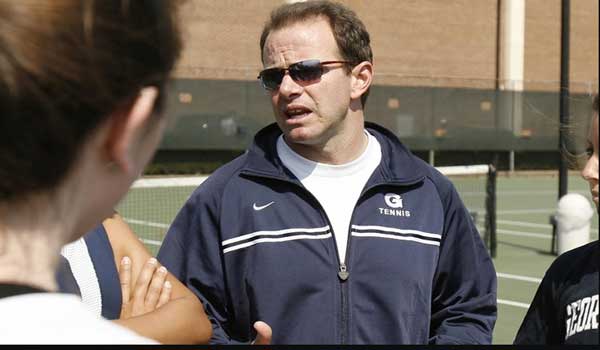 Former Georgetown tennis coach Gordie Ernst was sentenced July 1 to two and one half years in prison for conspiracy and bribery following a 2019 federal investigation into a nationwide college admissions case."Federal prosecutors described a scheme in which a college consultant in California, William (Rick) Singer, offered wealthy parents, including some celebrities, access to schools that decline most applicants, helping students to cheat on admissions tests and bribing coaches and others to label applicants as coveted recruits, even if they had no particular athletic talent," wrote the Washington Post. Ernst pled guilty to the charges in 2021."Mr. Ernst was one of the most prolific participants in cheating the college admissions system," said attorney Rachael Rollins. "He put nearly $3.5 million in bribes directly into his pocket and sold close to two dozen slots at Georgetown to the highest bidder." A previous statement by the University noted, in part, "Mr. Ernst has not coached our tennis team since December 2017, when he was placed on leave after the Office of Undergraduate Admissions identified irregularities in his recruitment practices and the University initiated an internal investigation. The investigation found that Mr. Ernst had violated University rules concerning admissions, and he separated from the University in 2018. The University was not aware of any alleged criminal activity or acceptance of bribes by Mr. Ernst until it was later contacted by the U.S. Attorney's Office, with whom we fully cooperated in its investigation. "Mr. Ernst's alleged actions are shocking, highly antithetical to our values, and violate numerous University policies and ethical standards... We have no indication that any other Georgetown employees were involved." Go East, Young Men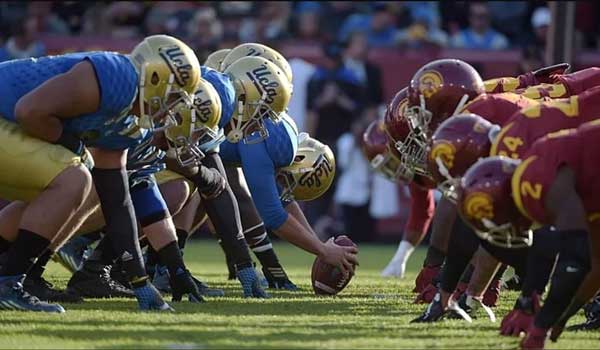 Despite clues hidden in plain sight, UCLA and the University of Southern California announced Thursday it will join the Big Ten Conference in 2024. What does this mean for college sports...and the Big East?
OFFICIAL STATEMENTS
College realignment was thought to be in a period of rest after last year's temblors that sent Texas & Oklahoma to the SEC in 2025, with changes across 17 other conferences that followed. Instead, the premise of a "power five" among major college programs wakes up today to the inevitability of a "power two", with as many as 40 schools aligned to either the Big Ten or Southeastern Conferences, covering 25 states and media rights of up to $1.8 billion dollars. According to the San Jose Mercury News, which broke the story, UCLA and USC may be worth up to $100 million each to the Big Ten, as would Notre Dame, whose days as an football independent may be numbered. The Pac-12, soon to be ten, has immediate concerns. As many as four of its schools are still potential additions to the Big Ten (California, Oregon, Stanford, Washington) with the remaining group needing to gain consensus whether to add schools from the Big 12, merge with the Big 12, or stay as a depleted conference without the Los Angeles TV market. Its TV contract of $41 million per school (roughly 10 times the Big East) is at risk given the changes. For its part, the Big 12, which stayed afloat last year by adding Brigham Young, Central Florida, Cincinnati and Houston, must decide if they will lose (or add) any schools from or to the Pac-12. The SEC stands at 16 but few expect them to stay at 16. As many as four schools from a short list of Atlantic Coast conference schools (Clemson, Florida State, Miami, North Carolina, Virginia) are likely adds, but the ACC maintains contractual obligations with its schools through 2036, with costs of up to $100 million to break the deal. The other ACC schools, particularly those that left the Big East in 2013, are not expansion targets and face a smaller, much less profitable conference in the future, with TV rights between that of the Pac-10 and Big 12, but just over half that of what the Big Ten and the SEC can offer. Next, there's the Big East. The Big East shares media rights partners with the Big Ten in Fox Sports, and the Big East TV deal is up for renewal in 2025. At 11 schools, the Big East could conceivably add one or more schools, although commissioner Val Ackerman deferred such talk when questions were posed during the conference tournament in March. If a renewal of the Fox contract with the Big East is sufficiently attractive and could be made more so with the right school, is there a major college program that would follow the model used by Connecticut (play football as an independent, but all other sports in the Big East) as a result? A Twitter post Thursday suggested the University of Kansas has considered it, but this appears to be unsubstantiated. In the meantime, college football fights on. School of Health Debuts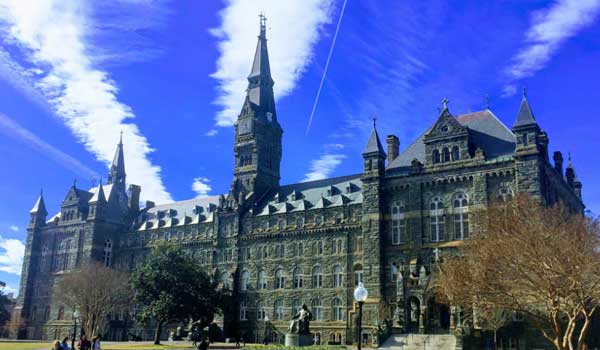 Off the sports pages, today begins the fifth undergraduate school at the University with the debut of the School of Health, Georgetown's first new undergraduate school since 1957.The official University release speaks in, well, very academic tones about the formation of the school-- rare is the Georgetown release these days which does not include unnecessary and expansive buzzwords such as "interdisciplinary", "intersectional", or "interdependent". Perhaps a simpler explanation is in order: the School of Nursing & Health Studies outgrew itself.Health studies arrived to the School of Nursing in the early 1990's, a period of declining admissions for aspiring nurses and unusually high acceptance rates to fill the class, approaching 70 percent some years. The revitalized School of Nursing & Health Studies brought new support from the University, and was as competitive as any of its undergraduate peers at GU-- a 12 percent accept rate this past year, for example. But the needs of a nursing curriculum are diverging from studies of public health, and thus the schools were split. Three departments of NHS (health systems administration, international health and human science) form the initial foundation of the SOH, and students in those majors will graduate under the school in 2023. Nursing will be the sole focus of the retitled School of Nursing, which dates to 1903 and issued its first undergraduate degrees in 1946. |